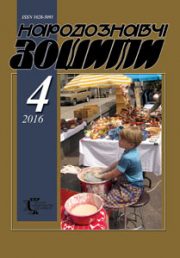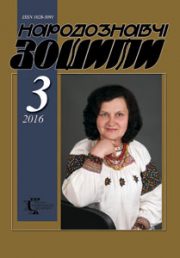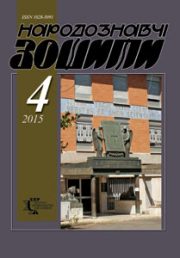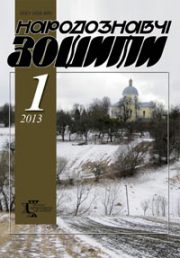The Ethnology Notebooks. 2020. № 4 (154), 945—953
UDK 39:305-055.2 (477)
DOI https://doi.org/10.15407/nz2020.04.945
IGNATENKO Iryna
- ORCID ID: https://orcid.org/0000-0001-8180-3582
- PhD, Associate Professor,
- Department of Ethnology and Regional Studies,
- Faculty of History,
- Taras Shevchenko National University of Kyiv
- 64/13, Volodymyrska Street,
- City of Kyiv, Ukraine, 01601
- Contacts: e-mail: iryna_ignatenko@ukr.net
Abstract. Introduction. Based on ethnological sources, the author explores the transition from wife to widowhood in the ethnic Ukrainian peasant culture of the mid-XIXth — early-XXth. Problem Statement. The author puts the attention on the role, social status but especially the sexuality of the young widow, the issue that has not been sufficiently studied in the Ukrainian ethnology. Purpose. The present study treats the lived experiences of young women from rural Ukrainian culture who have experienced the loss of a spouse. The key purpose is to show how widowhood influenced social, private and especial sexual life of Ukrainian women more than 200 years ago. Method. The ethnographic, historical, and folklore materials, which have been collected in this study, were analyzed by the feminist method. The author accepts and shares feminist ideas, patriarchal power, economic exploitation, sexuality, and reproduction are key mechanisms to understand the oppression of women in the past and modern society. Results. The keys message of the article is that the widow women were a subject of strict patriarchal control in social, private and intimate life. Despite the fact that the death of a husband enabled women to transcend the gender divide performing an unusual mix of male and female roles in public life, women’s independent was untypical and dangerous for the patriarch. So society pushes the women for second marriage but it was not easy task for practical realization. In the traditional worldview, the young widow had a bad reputation and has viewed as witch. Also, Widowed woman was marginalized socially and ritually in traditional society. That and other reasons made single women unattractive for marriage.
Keywords: woman, widow, widowhood, patriarchal, traditional culture, Ukraine.
Received 9.06.2020
REFERENCES
- Goryn, G. (1993). Public life of the rural population of the Ukrainian Carpathians (XIX — 30-s of XX century). Kyiv [in Ukrainian].
- Grymych, M. (Ed.). (2015). Status of widows in the Ukrainian customary law (XIX — the beginning of the XX century). Folk Culture of Ukrainians: Human Life Cycle: Historical and Ethnological Research: in 5 vol. Old age. Death. A culture of Honoring the Dead (Vol. 5, pp. 24—38). Kyiv [in Ukrainian].
- Kis, O. (2008). Women in the traditional Ukrainian culture in the second half of 19th — early 20th centures. Lviv [in Ukrainian].
- Serdyuk, I. (2011). Regimental townsfolk: historical and demographic characteristics of the urban population of the Hetmanate of the second half of the eighteenth century. Poltava [in Ukrainian].
- Andermahr, S., Lovell, T., & Wolkowitz, C. (1997). A glossary of feminist theory. London.
- Ignatenko, І. (2014). The Woman’s Body in Traditional Ukrainian Culture. Kyiv [in Ukrainian].
- Grushevsky, M., & Kuzelya, Z. (2017). The child in the customs and folk beliefs of the Ukrainian people. Reprint 1907. Kyiv [in Ukrainian].
- Mayerchyk, M., & Boriak, O. (Eds.). Inventings the Obscence. (2018). The Hidden Collection of Fedir Vovk. The Ethnography of Sexuality in the Late 19th and Early 20th Century. Kyiv [in Ukrainian].
- Hnatyuk, V., Balushko, V., Mayerchyk, M., & Boriak, O. (Eds.). (2013). About Studios «Antropofitei». Ethnography of Sexual life and Physicality (Pp. 32—39). Kyiv [in Ukrainian].
- Mayerchyk, M., & Boriak, O. (Eds.). (2003). The Body in the Texts of Cultures. Kyiv [in Ukrainian].
- Mayerchyk, M., & Boriak, O. (Eds.). (2013). Ethnography of Sexual life and Physicality. Kyiv [in Ukrainian].
- Ignatenko, I. (2016). The Man’s Body in the Ukrainian Traditional Culture. Kharkiv [in Ukrainian].
- Ignatenko, I. Sex and Talking about it in the Ukrainian village of XIX — beginning of XX century. Retrieved from:https://genderindetail.org.ua/season-topic/sexualnist/sex-ta-rozmovi-pro-nogo-v-ukrainskomu-seli-hih-pochatku-hh-stolittya-134390.html
- Ignatenko, I. (2019). Women’s breasts in the Traditional Worldwide of Ukrainians. Women’s Breasts: passion and pain (Pp. 200—212). Kiev [in Ukrainian].
- Kravets, O.M. (1966). Family Mode of Life and Customs of the Ukrainian People. Kyiv [in Ukrainian].
- Ponomarev, A.P., Naulko, V., Artyukh, L., & Gorlenko, V. (3 eds.). (1993). Family and Family’s Ritualism. Culture and Life of the Population of Ukraine: Textbook (Pp. 175—218). Kyiv [in Ukrainian].
- Ignatenko, I. (2017). Marriage and Family Relations in Traditional Ukrainian Culture. Kharkiv [in Ukrainian].
- Kravchenko, V. (2009). The works and materials on archival heritage. Kyiv: IMFE [in Ukrainian].
- Conger, V.B. (2009). The widows’ might widowhood and gender in early British America. New York.
- Bradbury, B. (2011). Wife to widow lives, laws, and politics in nineteenth century Montreal. Vancouver.
- Nesen, I., & Grymych, M. (Ed.). (2012). Ways of marking women’s ranks in the Ukrainian wedding. Folk Culture of Ukrainians: human life cycle: Historical and Ethnological Research: in 5 vol. Maturity. Womanhood. Female Subculture (Vol. 3, pp. 234—243). Kyiv [in Ukrainian].
- Borisenko, V., & Grymych, M. (Ed.). (2012). Women’s wedding ranks in the Traditional Ritual of Ukrainians. Folk Culture of Ukrainians: human life cycle: Historical and Ethnological Research: in 5 vol. Maturity. Womanhood. Female Subculture (Vol. 3, pp. 161—164). Kyiv [in Ukrainian].
- Comas-Via, M. (2017). Widowhood and economic difficulties in medieval Barcelona Historical Reflections (Vol. 43, issue 1, pp. 93—103).
- Svientsitsky, I. (1912). Burial weep. Ethnographic collection (Vol. ХХХІ—ХХХІІ). Lviv [in Ukrainian].
- Vinogradova, L.N. (2000). Folk Demonology and the Mythological and Ritual Tradition of the Slavs. Moscow [in Russian].
- Ivleva, L. (2004). The representations of the Eastern Slavs about evil spirits and contacts with them. The materials of the field and archival collections. Sankt-Peterburg [in Russian].
- Gnatyuk, V. (1912). The Knowledge of Galician-Russian Demonology. The Ethnographic Collection (Vol. XXXIII—XVII) [in Ukrainian].
- Gnatyuk, V. (2000). The essay on Ukrainian Mythology. Lviv [in Ukrainian].
- Myloradovich, V.P. (1889). The Notes about the Ukrainian Demonology. The Old Kyiv (Vol. 8, pp. 196—209). Kyiv [in Ukrainian].
- Chubynskiy, P. (1877). Proceedings of the ethnographic-statistical expedition to the Western Russian Region, equipped of the Imperial Russian Geographical Society. South-West Department. Proverbs, Puzzles, Witchcraft (Vol. 1, issue 2). Petersburg [in Ukrainian].
- Kis, O., & Grymych, M. (Ed.). (2012). Wife: on the issue of egalitarian marriedcouple. Folk Culture of Ukrainians: human life cycle: Historical and Ethnological Research: in 5 volumes. Maturity. Womanhood. Female Subculture (Vol. 3, pp. 203—216). Kyiv [in Ukrainian].
- Pelling, M., Cavallo, S., & Warner, L. (2 eds.). (1999). Finding widowers: men without women in England towns before 1700. Widowhood in medieval and early modern Europe. New York.
- Kis, O., & Grymych, M. (Ed.). (2012). The Ukrainian Witch: Life on the Margins. Folk Culture of Ukrainians: human life cycle: Historical and Ethnological Research: in 5 volumes. Maturity. Womanhood. Female Subculture (Vol. 3, pp. 293—303). Kyiv [in Ukrainian].
- Galaychuk, V. (2016). Ukrainian Mythology. Kharkiv [in Ukrainian].
- Ivanov, P.V., Ponomaryov, A., Kosmina, T., & Boryak, O. (3 eds.). (1991). Folk talkes about Witches and Vampires. Ukrainian: Folk Beliefs, Views, Witchcraft. Kyiv [in Ukrainian].
- Elliot, R. (1996). Gender, family and society Basingstoke: Macmillan; New York.







